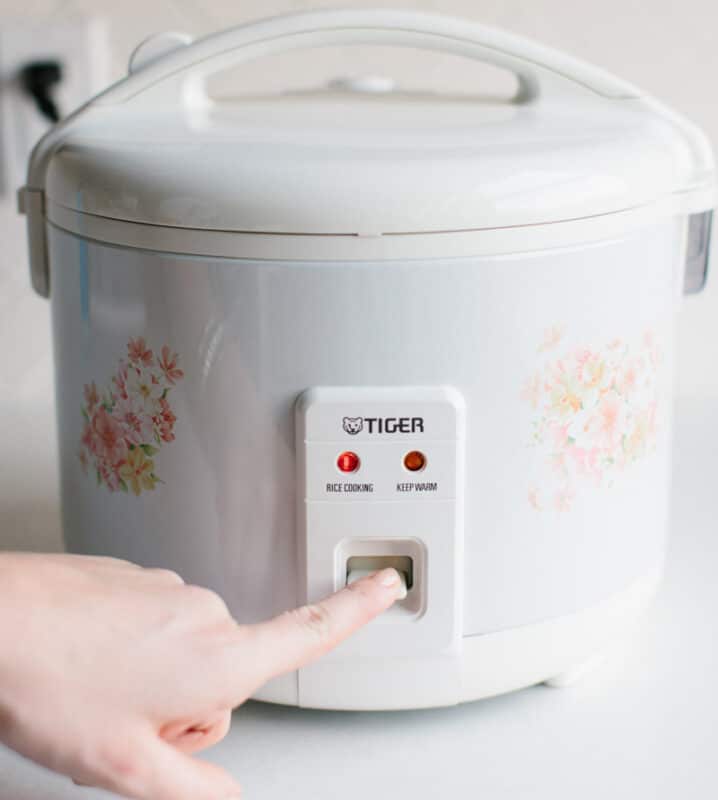Is your rice cooker not shutting off and burning rice? A failing component could be causing all your problems. Here’s 5 fixes.
Since the day they were invented, rice cookers have simplified our lives and saved us countless cooking hours, but what happens when they start causing more problems than they solve, and burn your rice to a crisp?
A smokey kitchen and a ruined meal are definitely not what you signed up for, but you still have to deal with it to figure out the cause behind it. I’ll be honest with you, at this point, it could be virtually anything. From faulty components, to using the wrong kind of rice.
And while you’re probably about ready to throw your appliance in the bin. Don’t do it just yet. As frustrating as it can be to have this happen to you, fixing the issue is very simple and should take no longer than 20 minutes, at the most.
Below, you’ll find a list of the most common reasons why this happens and what you can do to address them.
Are you ready? Let’s get you back to enjoying fluffy rice!
Your Rice Cooker Might Be Giving You Trouble Due To…
- Its design
- Using the wrong kind of rice
- A faulty thermostat
- A bad heating element
- A broken switch
I believe troubleshooting should be done methodically, and trying to avoid unnecessary disassembling, which is why the items on this list range from external, to internal factors.
For most of these fixes and tests, all you will need is patience and a screwdriver, but if you happen to have a multimeter handy, it’s a good idea to bring it to the table.
#1 Its Design
There might not be an “off” button
There’s always the possibility that your rice cooker is perfectly fine, and you might have missed something from the user manual.
This is much more likely if you just bought your appliance. Many rice cookers do not come equipped with an “off” button, there’s only “on”, and “standby”, which is rice cooker code for keeping your rice warm.
Believe it or not, if your rice cooker does not have an “off” option, it was probably either designed to just be unplugged after you’re done using it or has an auto-off function. If this isn’t the case, there might be something wrong with your switch, but we’ll get to that.
Solution: Read the user manual again to determine whether your rice cooker has this option.
If it doesn’t, mystery solved!
#2 You’re Using the Wrong Kind of Rice
Precooked rice can burn faster
If you’re in the habit of using precooked rice, you might be contributing to the burning situation. Let me explain.
As its name suggests, precooked rice has been cooked slightly before packaging, which means that it will be ready much faster than its regular, uncooked version.
While rice cookers are built to cook all types of rice, setting the wrong temperature or time for the variant of your choice will most likely result in burning.
Solution: Be mindful about the type of rice you’re using. Uncooked, unprocessed rice might require different conditions than precooked alternatives. If you’re unsure as to how you can cook it, a quick Google search can answer your questions.

#3 You Have a Faulty Thermostat
Another reason why your rice cooker might be burning your rice is a failing thermostat.
This component is solely responsible for measuring the temperature inside your appliance and sending signals to your heating element in order to reduce or increase it depending on the situation.
When it breaks or malfunctions, it can either make your rice cooker not heat up at all, or cause overheating, which can result not only in burned rice, but also blown fuses, internal damage, and even fires.
Solution: Ok, it’s time to bring out the tools I mentioned earlier. Please follow these steps:
- Unplug your rice cooker and let it cool down
- Locate the screws at the bottom and undo them with your screwdriver
- Expose the appliance’s guts
- Locate your thermostat and access it
- Test for conductivity with your multimeter
Remember, no conductivity means that the component is no longer functional, and must be replaced.
#4 Your Heating Element Is Done For
A faulty heating element can cause overheating
Burned rice could also mean that your rice cooker is having trouble regulating its internal temperature from the source.
Your heating element is responsible for taking the electricity from your rice cooker’s power cord, and transforming it into heat that your thermostat then regulates and adjusts.
When it fails, your rice cooker can no longer control how hot it gets, and more often than not, the consequences range from charred food, to irreparable damage to your appliance.
If you suspect this to be the issue, I strongly advise against using your rice cooker until you fix this to prevent any catastrophes. Better safe than sorry!
Solution: Follow the steps from the previous point to access the appliance’s guts and test for conductivity and viability.
If you’re a visual person like me, or need some extra guidance, there are tons of detailed YouTube videos you can refer to.
#5 The Knob Switch Is Broken
Your switch might be broken
Last, but not least, is the possibility of a broken switch. If your rice cooker does have an “off” button or dial in the main knob, but it’s not working, the switch that controls it may be malfunctioning.
If this is the issue, there’s no reason to panic. As opposed to other possible causes in this list, a broken switch does not put you or your appliance in any immediate danger, and you can always just unplug it until you feel ready to try and repair it.
Solution: Follow the steps from point #3 and look for the switch behind the external knobs or dials.
If you determine that you need to replace the switch, you can find all the spare parts you need at your nearest hardware store.

Conclusion
An unresponsive rice cooker is always a problem. Even more so when it’s burning your rice as well.
When a household appliance as vital as this one fails, there are always a wide range of possible explanations, remember to do your best to try and isolate them to address them individually. This will save you time and money.
You should stop using your rice cooker at the first sign of overheating, as this can not only reduce your appliance’s life span, but also put you at risk. Always try your best to look into these anomalies as soon as possible.
Moreover, if at any point during this process you feel overwhelmed or doubtful, there’s no shame in calling a technician and getting some additional help. Safety should always be your top priority.
Besides, even if you don’t do the repairs yourself, you can still learn from watching the professionals work.
Thank you for reading. If you found this article useful and learned something new, why not continue your journey of knowledge with our other great resources below?
Happy projects!







